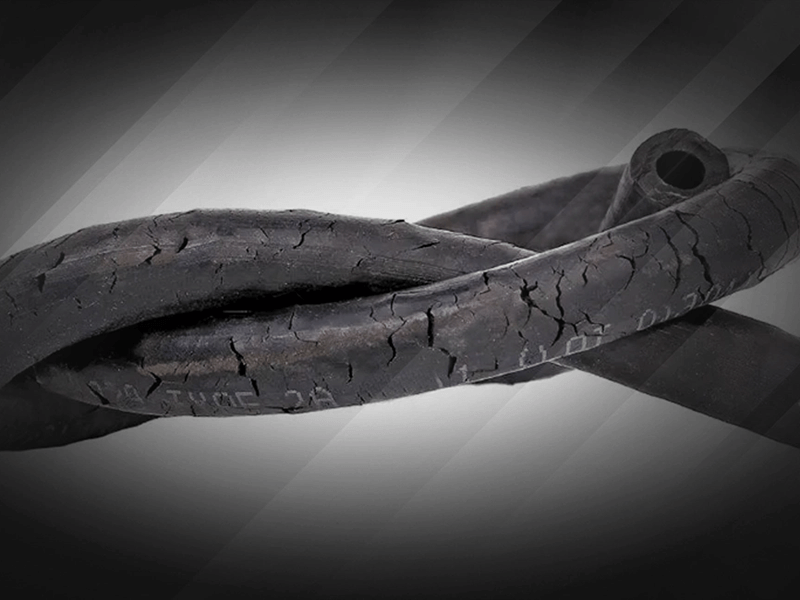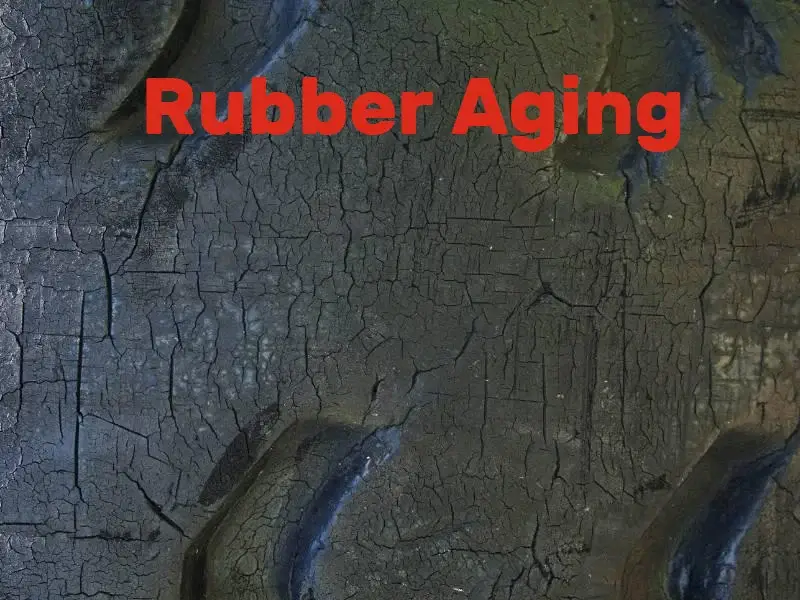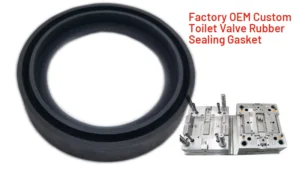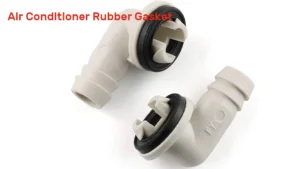The consequences of rubber aging can be significant, ranging from reduced rubber product lifespan, rubber parts deterioration, and increased maintenance costs to potential safety hazards and operational failures. By understanding the mechanisms and factors contributing to rubber aging, industries can develop strategies to mitigate its effects and prolong the lifespan of rubber components, thus enhancing product reliability and safety. Understanding rubber aging is vital for industries to ensure the longevity, reliability, and safety of products that rely on rubber materials. By addressing the challenges posed by rubber aging through preventive measures and mitigation strategies, industries can optimize performance, reduce costs, and enhance customer satisfaction. Today, we will explore the rubber aging causes and prevent causes.
What is Rubber Aging?
Rubber aging refers to the process by which rubber materials degrade over time due to exposure to environmental factors such as heat, light, oxygen, ozone, mechanical stress, and chemical exposure. This degradation can lead to rubber deterioration and changes in the physical, mechanical, and chemical properties of rubber, ultimately affecting its performance and lifespan.
The aging process typically involves the degradation of polymer chains within the rubber material, leading to phenomena such as oxidation, cross-linking, chain scission, and the formation of cracks or surface defects. As a result, aged rubber may exhibit reduced elasticity, tensile strength, flexibility, and resistance to abrasion or tearing.
 What is Rubber Aging?
What is Rubber Aging?
What Causes of Rubber Aging?
Rubber aging is caused by a combination of factors and stressors that gradually degrade the material over time. The primary causes of rubber aging include:
Thermal Caused Rubber Aging:
Exposure to high temperatures accelerates the degradation of rubber molecules through thermal oxidation reactions. At elevated temperatures, oxygen molecules react with rubber polymer chains, leading to the formation of free radicals. These free radicals initiate chain scission and cross-linking reactions within the rubber matrix, causing molecular breakdown and structural changes. As a result, aged rubber may exhibit reduced elasticity, increased hardness, and decreased resistance to deformation and mechanical stress.
Oxygen Caused Rubber Aging:
Oxygen in the rubber reacts with the free radical chain of the rubber molecule, causing chain scission or excessive crosslinking, which changes the rubber properties. Oxidation is a major reason for rubber aging.
Light Caused Rubber Aging:
Light, especially ultraviolet (UV) radiation can initiate photochemical reactions in rubber molecules, leading to the formation of reactive oxygen species (ROS). ROS then reacts with rubber polymer chains, causing oxidation and degradation of molecular structure. This oxidative degradation can result in the formation of surface cracks, discoloration, and loss of mechanical properties in rubber materials exposed to sunlight or artificial light sources.
Ozone Caused Rubber Aging:
Ozone is highly chemically active and more destructive than oxygen. It is present in the atmosphere or generated in industrial processes, can penetrate rubber surfaces, and induces oxidative degradation. Ozone molecules react with unsaturated carbon-carbon double bonds present in rubber polymer chains, forming ozonides and other reactive intermediates. These reactive species lead to the cleavage of polymer chains and the formation of surface cracks, known as ozone cracking or ozone degradation. Ozone aging is particularly problematic for rubber materials exposed to outdoor environments, where ozone concentrations are higher, leading to premature degradation and failure.
Mechanical Caused Rubber Aging:
Repeated stretching, compression, and flexing of rubber components during service or manufacturing processes can accelerate aging through mechanical fatigue. Mechanical stress causes localized deformation and molecular rearrangement within the rubber matrix, leading to the initiation and propagation of cracks. Over time, these fatigue cracks can propagate and coalesce, compromising the integrity and mechanical properties of the rubber material. Mechanical aging is especially prevalent in dynamic applications such as tires, seals, and conveyor belts, where rubber components experience cyclic loading and deformation.
Chemical Caused Rubber Aging:
Exposure to chemicals such as acids, bases, solvents, and fuels can lead to chemical degradation and rubber deterioration. Chemicals can interact with rubber molecules through processes such as swelling, softening, or degradation, depending on their chemical compatibility and concentration. Acidic or alkaline environments can catalyze hydrolysis reactions, leading to the cleavage of polymer chains and loss of mechanical strength.
Preventing rubber aging involves implementing measures to minimize exposure to environmental factors and stressors that contribute to degradation. Here are several ways to prevent rubber aging:
What Are the Ways to Prevent Rubber Aging?
Preventing rubber aging involves implementing measures to minimize exposure to environmental factors and stressors that contribute to degradation. Here are several ways to prevent rubber aging:
Proper Storage & Handling to Prevent Rubber Aging
Store rubber products in cool, dry, and well-ventilated areas away from direct sunlight, heat sources, and ozone-generating equipment. Use protective packaging, such as sealed bags or containers, to shield rubber materials from exposure to moisture, dust, and contaminants during storage and transportation. Handle rubber products with care to avoid excessive bending, stretching, or compression that can induce mechanical stress and accelerate aging.
Prevent Rubber Aging with Protective Coatings and Treatments
Apply protective coatings, such as UV-resistant coatings or ozone-resistant coatings, to rubber surfaces exposed to sunlight or outdoor environments.
Treat rubber materials with anti-oxidants, UV stabilizers, or ozone inhibitors to enhance their resistance to oxidative degradation and photo-oxidative aging.
Preventing Rubber Aging by Controlling Environmental Condition
Control temperature and humidity levels in manufacturing facilities, storage areas, and operational environments to minimize thermal aging and moisture-related degradation of rubber materials.
Install air filtration systems or ozone scrubbers in industrial settings to reduce ozone concentrations and mitigate ozone-induced aging of rubber components.
Rubber Aging Prevention Through Material Selection and Formulation
Choose rubber compounds and formulations that are specifically designed for the intended application and environmental conditions.
Select additives, fillers, and reinforcements that enhance the durability, UV resistance, and chemical compatibility of rubber materials.
Optimize vulcanization processes and curing parameters to achieve the desired balance of mechanical properties and aging resistance in rubber products.
Regular Inspection and Maintenance of Rubber Components
Implement routine inspection and maintenance schedules to detect signs of aging, wear, or degradation in rubber components.
Replace aged or damaged rubber parts promptly to prevent potential failures, safety hazards, or performance issues in machinery, equipment, or infrastructure.
Conduct periodic testing and evaluation of rubber materials using accelerated aging tests, such as heat aging, UV exposure, ozone exposure, and mechanical fatigue testing, to assess their long-term performance and durability.
Environmental Protection Measures for Rubber Aging Prevention
Implement pollution control measures and environmental management practices to minimize exposure of rubber materials to harmful chemicals, solvents, and pollutants.
Comply with regulatory requirements and industry standards for handling, storage, and disposal of rubber products and waste materials to reduce environmental impact and prevent contamination.
Conclusion
Rubber aging is a complex process driven by environmental factors and stressors, the rubber materials will gradually degrade and lead to rubber deterioration over time. We’ve explored the various causes and prevention of rubber aging. By taking proactive steps to address rubber aging, industries can optimize performance, reduce costs, enhance customer satisfaction, and contribute to sustainable and efficient operations across a wide range of applications.






